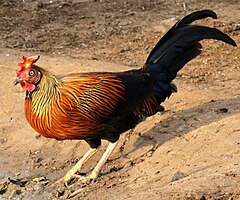Gallus (rodzaj ptaków)
| Gallus[1] | |||
| Brisson, 1760[2] | |||
 Przedstawiciel rodzaju – kur cejloński (G. lafayetii) | |||
| Systematyka | |||
| Domena | |||
|---|---|---|---|
| Królestwo | |||
| Typ | |||
| Podtyp | |||
| Gromada | |||
| Podgromada | |||
| Infragromada | |||
| Rząd | |||
| Rodzina | |||
| Podrodzina | |||
| Plemię | |||
| Rodzaj | Gallus | ||
| Typ nomenklatoryczny | |||
Phasianus gallus Linnaeus, 1758 | |||
| Synonimy | |||
| Gatunki | |||
| |||
Gallus – rodzaj ptaka z podrodziny bażantów (Phasianinae) w rodzinie kurowatych (Phasianidae).
Zasięg występowania
Rodzaj obejmuje gatunki występujące w orientalnej Azji[7].
Morfologia
Długość ciała samców 65–80 cm, samic 35–46 cm; masa ciała samców 672–1450 g, samic 485–1050 g,[7].
Systematyka
Etymologia
- Gallus: łac. gallus „kogut, kogut gospodarski”[8].
- Alector: gr. αλεκτωρ alektōr, αλεκτορος alektoros „kogut”[8]. Gatunek typowy: Phasianus gallus Linnaeus, 1758.
- Creagrius: gr. κρεαγριον kreagrion „haczyk, widły” (tj. haczyko-ogonowy), od zdrobnienia κρεαγρα kreagra „hak do mięsa”, od κρεας kreas, κρεως kreōs „mięso”; αγρεω agreō „złapać”[8]. Gatunek typowy: Phasianus varius Shaw, 1798.
- Gallina: łac. gallina „kura”, od gallus „kogut”[8]. Gatunek typowy: Phasianus gallus Linnaeus, 1758.
- Pliogallus: gr. πλειων pleiōn „więcej, większy”, forma wyższa od πολυς polus „dużo”; rodzaj Gallus Brisson, 1760 (kur)[8]. Gatunek typowy: †Pliogallus crassipes Gaillard, 1939.
Podział systematyczny
Do rodzaju należą następujące gatunki[9]:
- Gallus varius (Shaw, 1798) – kur zielony
- Gallus gallus (Linnaeus, 1758) – kur bankiwa
- Gallus sonneratii Temminck, 1813 – kur siwy
- Gallus lafayettii Lesson, 1831 – kur cejloński
Przypisy
- ↑ Gallus, [w:] Integrated Taxonomic Information System [online] (ang.).
- ↑ M.J. Brisson: Ornithologie, ou, Méthode contenant la division des oiseaux en ordres, sections, genres, especes & leurs variétés: a laquelle on a joint une description exacte de chaque espece, avec les citations des auteurs qui en ont traité, les noms quils leur ont donnés, ceux que leur ont donnés les différentes nations, & les noms vulgaires. T. 1. Parisiis: Ad Ripam Augustinorum, apud Cl. Joannem-Baptistam Bauche, bibliopolam, ad Insigne S. Genovesae, & S. Joannis in Deserto, 1760, s. 26, 166. (łac. • fr.)
- ↑ F. de P. von Schrank: Fauna Boica: durchgedachte Geschichte der in Baiern einheimischen und zahmen Thiere. T. 1. Nürnberg: in der Stein’schen Buchhandlung, 1798, s. 135. (niem.)
- ↑ C.W.L. Gloger: Gemeinnütziges Hand- und Hilfsbuch der Naturgeschichte. Breslau: A. Schulz, 1841, s. 387. (niem.)
- ↑ G.R. Gray: A list of the genera of birds: with their synonyma an indication of the typical species of each genus. Wyd. 2. London: R. and J.E. Taylor, 1841, s. 78. (ang.)
- ↑ C. Gaillard. Contribution a l’étude des oiseaux fossiles. „Archives du Muséum d'Histoire Naturelle de Lyon”. 15 (2), s. 59, 1939 (fr.).
- ↑ a b D.W. Winkler, S.M. Billerman & I.J. Lovette: Pheasants, Grouse, and Allies (Phasianidae), version 1.0. W: S.M. Billerman, B.K. Keeney, P.G. Rodewald & T.S. Schulenberg (red.): Birds of the World. Ithaca, NY: Cornell Lab of Ornithology, 2020. DOI: 10.2173/bow.phasia1.01. [dostęp 2020-05-28]. (ang.)

- ↑ a b c d e Etymologia za: James A. Jobling: The Key to Scientific Names (ang.). W: Birds of the World [on-line]. Cornell Lab of Ornithology, Ithaca, NY, USA, 2021.
- ↑ Systematyka i nazwy polskie za: P. Mielczarek & M. Kuziemko: Plemię: Gallini Brehm,CL, 1831 (wersja: 2020-04-13). W: Kompletna lista ptaków świata [on-line]. Instytut Nauk o Środowisku Uniwersytetu Jagiellońskiego. [dostęp 2020-05-28].
Media użyte na tej stronie
Autor: Jakob Voß, influenced by original art designed at PLoS, modified by Wikipedia users Nina and Beao, Licencja: CC0
Closed Access logo, derived from PLoS Open Access logo. Alternative version.
Autor: (of code) -xfi-, Licencja: CC BY-SA 3.0
The Wikispecies logo created by Zephram Stark based on a concept design by Jeremykemp.
Autor: Thimindu, Licencja: CC BY-SA 3.0
Sri Lanka Junglefowl, Yala, Sri Lanka.


